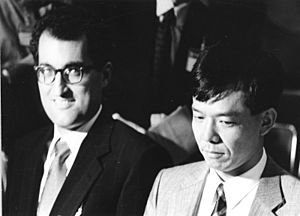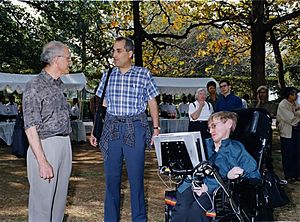Edward Witten facts for kids
Quick facts for kids
Edward Witten
|
|
|---|---|

Witten in 2008
|
|
| Born | August 26, 1951 Baltimore, Maryland, U.S.
|
| Alma mater | |
| Known for |
|
| Spouse(s) | Chiara Nappi |
| Children | 3, including Ilana B. and Daniela |
| Parent(s) |
|
| Relatives |
|
| Awards |
|
| Scientific career | |
| Fields | |
| Institutions | |
| Thesis | Some Problems in the Short Distance Analysis of Gauge Theories (1976) |
| Doctoral advisor | |
| Doctoral students |
|
Edward Witten (born August 26, 1951) is an American theoretical physicist who is a leading researcher in string theory. This is an idea that suggests the tiniest particles in the universe are not points, but tiny, vibrating "strings." He is also a professor at the famous Institute for Advanced Study in Princeton, New Jersey.
Witten is known for his incredible ability to use mathematics to solve problems in physics. His work is so good that in 1990, he became the first physicist ever to win the Fields Medal, which is often called the "Nobel Prize of mathematics." He is also considered the main founder of M-theory, a theory that tries to unite all the different versions of string theory.
Contents
Early Life and Education
Edward Witten was born in Baltimore, Maryland. His father, Louis Witten, was also a theoretical physicist who studied gravity. This means Edward grew up in a family that was very interested in science.
But as a young man, Witten wasn't sure he wanted to be a scientist. He went to Brandeis University and studied history and linguistics. He was also interested in politics and journalism. For a short time, he worked on the presidential campaign of George McGovern in 1972.
After trying out economics in college, he realized his true passion was in science. He enrolled at Princeton University in 1973 to study physics. He earned his PhD in 1976 under the guidance of David Gross, who later won a Nobel Prize.
Witten's Amazing Research
Witten's work connects physics and math in new and exciting ways. He has had a huge impact on how scientists understand the universe.
Winning the Fields Medal
The Fields Medal is one of the highest honors a mathematician can receive. It was a huge surprise when Witten, a physicist, won it in 1990. The mathematician Michael Atiyah explained why Witten deserved the award.
Although he is definitely a physicist... his command of mathematics is rivaled by few mathematicians, and his ability to interpret physical ideas in mathematical form is quite unique. Time and again he has surprised the mathematical community by a brilliant application of physical insight leading to new and deep mathematical theorems...

Atiyah pointed out three main areas of Witten's work:
- Understanding Knots with Physics: Witten used ideas from physics to study the mathematics of knots. He created a new field called topological quantum field theory. This helped mathematicians understand knots and shapes in a completely new way.
- Proving Energy is Positive: In 1981, Witten proved the positive energy theorem. This theorem says that the total energy in a system with gravity is always positive or zero. It can only be zero if space is completely empty and flat. This proved that empty space is stable, which is a very important idea in general relativity.
- Connecting Physics and Shapes: Witten also used ideas from supersymmetry (a theory that connects different types of particles) to solve problems in Morse theory. Morse theory is a branch of math that studies the shapes of complex objects called manifolds.
What is M-Theory?
By the 1990s, scientists had five different versions of string theory. Each one seemed to work, but they were all slightly different. This was confusing. Which one was the correct theory for our universe?
In 1995, Witten gave a famous talk where he proposed a shocking idea. He suggested that the five string theories were not different theories at all. Instead, he said they were all just different views of one single, deeper theory. He called this new idea M-theory.
Imagine five people describing an elephant in a dark room. One person touches the trunk and says it's a snake. Another touches a leg and says it's a tree. They are all describing the same elephant, just from different perspectives. Witten's M-theory was like turning on the light and showing everyone the whole elephant. This idea started a "second superstring revolution" and changed the field of physics.
Other Important Work
Witten has made many other important contributions. He helped develop the AdS/CFT correspondence, a powerful idea that connects theories of gravity with quantum field theories. Think of it as a "dictionary" that allows scientists to translate between two different types of physics.
He has also worked with other scientists, like Nathan Seiberg, to make major discoveries in quantum field theory. Their work led to new mathematical tools, called Seiberg–Witten invariants, that help mathematicians study complex four-dimensional shapes.
Awards and Personal Life
Because of his incredible work, Witten has received many of the top awards in science. Besides the Fields Medal, he has won the National Medal of Science, the Breakthrough Prize in Fundamental Physics, and the Isaac Newton Medal. Many scientists consider him to be one of the smartest physicists alive today.
Witten is married to Chiara Nappi, who is also a physics professor at Princeton University. They have three children. Two of their daughters, Ilana and Daniela, also became successful scientists.
He is also interested in world affairs. He supports finding a peaceful solution to the conflict between Israel and Palestine.
See also
 In Spanish: Edward Witten para niños
In Spanish: Edward Witten para niños


